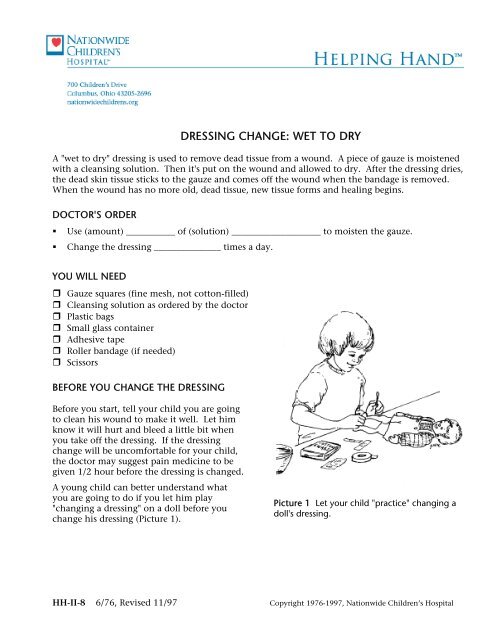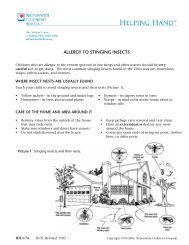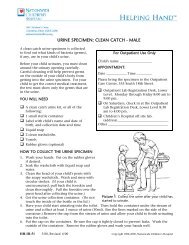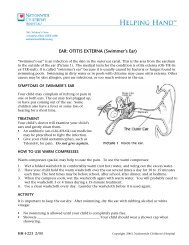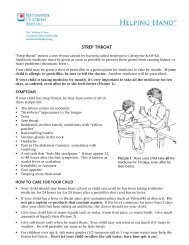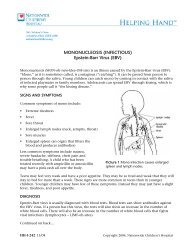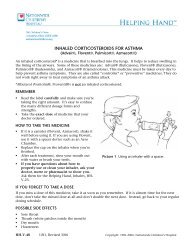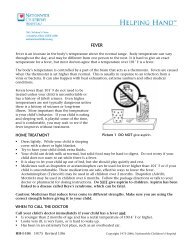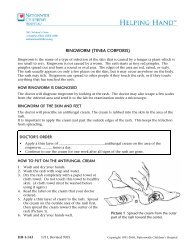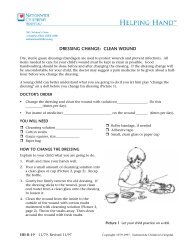You also want an ePaper? Increase the reach of your titles
YUMPU automatically turns print PDFs into web optimized ePapers that Google loves.
<strong>DRESSING</strong> <strong>CHANGE</strong>: <strong>WET</strong> <strong>TO</strong> <strong>DRY</strong><br />
A "wet to dry" dressing is used to remove dead tissue from a wound. A piece of gauze is moistened<br />
with a cleansing solution. Then it's put on the wound and allowed to dry. After the dressing dries,<br />
the dead skin tissue sticks to the gauze and comes off the wound when the bandage is removed.<br />
When the wound has no more old, dead tissue, new tissue forms and healing begins.<br />
DOC<strong>TO</strong>R'S ORDER<br />
• Use (amount) ___________ of (solution) ____________________ to moisten the gauze.<br />
• Change the dressing _______________ times a day.<br />
YOU WILL NEED<br />
Gauze squares (fine mesh, not cotton-filled)<br />
Cleansing solution as ordered by the doctor<br />
Plastic bags<br />
Small glass container<br />
Adhesive tape<br />
Roller bandage (if needed)<br />
Scissors<br />
BEFORE YOU <strong>CHANGE</strong> THE <strong>DRESSING</strong><br />
Before you start, tell your child you are going<br />
to clean his wound to make it well. Let him<br />
know it will hurt and bleed a little bit when<br />
you take off the dressing. If the dressing<br />
change will be uncomfortable for your child,<br />
the doctor may suggest pain medicine to be<br />
given 1/2 hour before the dressing is changed.<br />
A young child can better understand what<br />
you are going to do if you let him play<br />
"changing a dressing" on a doll before you<br />
change his dressing (Picture 1).<br />
Picture 1 Let your child "practice" changing a<br />
doll's dressing.<br />
HH-II-8 6/76, Revised 11/97 Copyright 1976-1997, Nationwide Children’s Hospital
Dressing: Wet to Dry Page 2 of 2<br />
HOW <strong>TO</strong> <strong>CHANGE</strong> THE <strong>DRESSING</strong><br />
1. Wash and rinse your hands (Picture 2).<br />
2. Unfold a gauze square until there is one<br />
layer. Place the square in a clean glass.<br />
3. Pour enough cleansing solution over the<br />
gauze to make it wet (Picture 3). Recap<br />
the bottle.<br />
4. Wash your hands again.<br />
5. Remove the old dressing from your child's<br />
wound and place it in a plastic bag.<br />
6. Clean the inside of the wound with a 2 x<br />
2 or 4 x 4 gauze pad moistened with<br />
cleansing solution (Picture 4). Throw<br />
away the gauze pad in the bag.<br />
7. Clean around the outside of the wound<br />
with a gauze pad moistened with<br />
solution. Throw away the gauze pad.<br />
8. Look at the wound to see if it's healing<br />
(see When to Call the Doctor below). The<br />
wound should be pink and may have<br />
some bleeding.<br />
9. Place the moist gauze on the wound<br />
10.Cover it with a dry gauze square.<br />
10. Tape the edges of the dry gauze. If the<br />
wound is large or difficult to tape<br />
securely, wrap a clean roller bandage over<br />
the gauze (Picture 5). Tape the end of the<br />
roller bandage.<br />
11. Throw away the old dressing. Throw<br />
away the used cleansing solution.<br />
12. Wash your hands again.<br />
13. Store all supplies out of the reach of<br />
children.<br />
WHEN <strong>TO</strong> CALL THE DOC<strong>TO</strong>R<br />
Call your child’s doctor if you don't think the<br />
wound is healing. If the wound isn't healing<br />
properly, you'll see one or more of these signs:<br />
• Change in drainage from wound (color,<br />
odor, or amount).<br />
• Swelling or redness around wound.<br />
• Child has a fever over 101°F by mouth or<br />
102°F by rectum.<br />
If you have any questions, please ask your<br />
doctor or nurse or call _________________.<br />
Picture 2 Wash your hands.<br />
Picture 3 Place the gauze in a glass. Pour<br />
solution over the gauze.<br />
Picture 4 Clean the wound. Cover with dry<br />
gauze.<br />
Picture 5 If the wound is large, wrap a roller<br />
bandage over the gauze.


